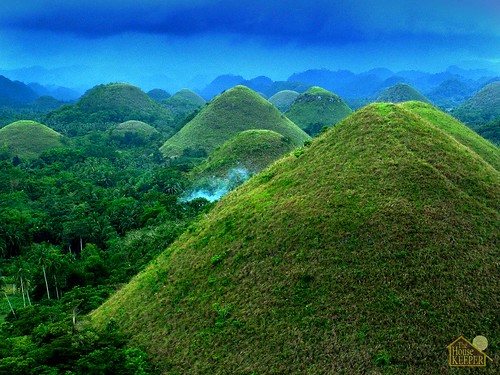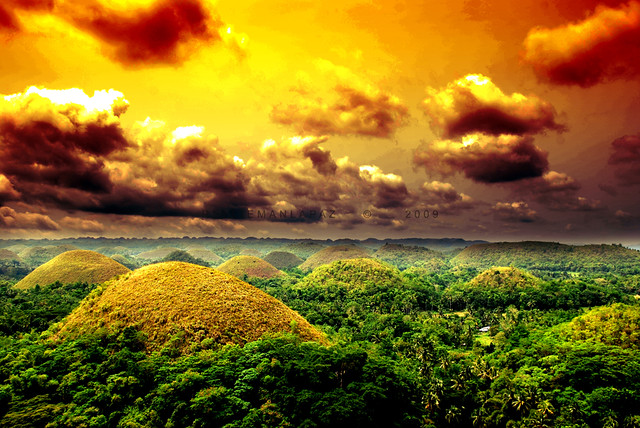The Chocolate Hills are an unusual geological formation in Bohol,Philippines. According to the latest accurate survey done, there are 1,776 hills spread over an area of more than 50 square kilometres (20 sq mi). They are covered in green grass that turns brown during the dry season, hence the name.


Chocolate Hills, Philippines
During the dry season, the grass-covered hills dry up and turn chocolate brown. This transforms the area into seemingly endless rows of "chocolate kisses".

Hills during the dry season
Grass species found to thrive on the hills are Imperata cylindrical and Saccharum spontaneum and several Compositae and ferns. Trees grow on the base of the hills and are lush and verdant rings around the almost bare cone-shaped hills resulting in its awesome natural beauty.

Road through the chocolate hills
The Chocolate Hills is a rolling terrain of haycock hills – mounds of general shape which are conical and almost symmetrical. Estimated to be at least 1,268 individual mounds to about 1,776, these cone-shaped or dome-shaped hills are actually made of grass-covered limestone.

The domes vary in sizes from 30 to 50 metres (98 to 160 ft) high with the largest being 120 metres (390 ft) in height. Bohol's "main attraction," these unique mound-shaped hills are scattered by the hundreds throughout the towns of Carmen, Batuan and Sagbayan in Bohol.

Aerial photo of hills
The most acceptable geological theory of the hills is that the hills were the result of thousands of years of weathering of marine limestone. Others say that the hills were formed ages ago by the uplift of coral deposits or that they erupted from the sea in a massive geologic shift, and the action of rain water and erosion for the past thousand years put in the finishing touches.
2. Bohol's Tarsier
The Philippine tarsier, (Tarsius syrichta) is very peculiar small animal. In fact it is one of the smallest known primates, no larger than a adult men's hand. Mostly active at night, it lives on a diet of insects. Folk traditions sometimes has it that tarsiers eat charcoal, but actually they retrieve the insects from (sometimes burned) wood. It can be found in the islands of Samar, Leyte, Bohol, and Mindanao in the Philippines.

Bohol's tarsier

A mother and child Tarsier
If no action is taken, the tarsier might not survive. Although it is a protected species, and the practice of catching them and then selling them as stuffed tarsiers to tourists has stopped, the species is still threatened by the destruction of his natural forest habitat. Many years of both legal and illegal logging and slash-and-burn agriculture have greatly reduced these forests, and reduced the tarsier population to a dangerously small size. If no action is taken now, the Philippine tarsier can soon be added to the list of extinct species.

"The world's smallest monkey" is an often heard slogan. However, it is not a monkey. In truth, its classification is somewhat problematic. Some scientists consider tarsiers to be a taxonomic suborder among the primates. While, because they are closely related to lemurs, lorises and bushbabies, others classify them with the prosimians to which these animals belong.


Sleepiness
As of toe-to-head, the tarsiers determine merely around 8 – 16 cm. That is merely about the dimension of a telephone. In spite of its mass, tarsiers can perform astonishing things similar to providing their heads a spin of almost 180 degree, as well as jump to a stature of 16 ft! Locals mention Tarsiers as Maomag. Moreover the various other appealing features of Tarsiers take account of a tail that is similar to a rat and moreover has an extent longer when compared with its body. It as well has ears, which bear a resemblance to the ears of the bat as well as the way by which a tarsier can travel in competition of one another.

Afternoon rest
Tarsiers live in the Tarsier Sanctuary. The Tarsier Sanctuary is an extensive 134 hectares of the forested terra firma. In addition the Tarsier Sanctuary is placed in the midst of the townships of Sicatuna as well as Corella located in Bohol.Tarsier Sanctuary frequented by tourists.
Source
